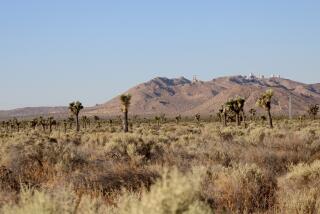Astronomers Warn of Light Pollution From Hidden Creek Ranch
- Share via
MOORPARK — Critics have attacked the Hidden Creek Ranch project from just about every angle imaginable.
Opponents of the housing and retail proposal, which could create up to 3,220 homes and increase the city’s population by one-third, have blasted the project for potential traffic congestion, air pollution, possible ground contamination and urban sprawl.
During the third of four public hearings on the Hidden Creek Ranch proposal, members of the Ventura County Astronomical Society Wednesday brought up a new concern: light pollution.
The society--which helps operate Moorpark’s Charles Temple Observatory, Ventura County’s sole observatory--worried about the impact that lights from the project’s homes, streets, shopping centers and businesses might have on the night sky.
“It’s a detrimental impact in the fact that the sky glow, also called light pollution, from the heavy lights will basically opaque the sky, which means you can’t see through it,” said Jim Cassou, a representative of the society, which includes more than 200 professional and amateur astronomers.
“The objects we need to look at are deep-sky objects that are dim to begin with,” he said. “When you put this opaque cover over it, they basically disappear.”
Built in 1986, the Charles Temple Observatory, situated on the northeast section of Moorpark College, frequently holds lectures and star-gazing parties in the summer.
The society also uses the observatory to help teach Moorpark College astronomy students about the stars, planets, comets and the moon.
Although the observatory is not a world-renowned research facility, its officials say amateur astronomers have frequently made important discoveries. For instance, Thomas Bopp, an amateur, was one of the two men who discovered the Hale-Bopp Comet.
The local astronomy group has asked the Moorpark City Council to deny the massive Hidden Creek Ranch project. The group, however, has asked if the council approves the proposal that the developers be required to build a new observatory as far and as high away from the development as possible.
The group also urged the use of low-light wattage and lights that are aimed down rather than toward the sky.
“If we lose the deep sky-type objects, which are just beautiful, we aren’t going to be able to show anyone anything but the moon and the planets,” Cassou said. “And there’s nothing like seeing a young boy and girl and the telescope looking out and getting really excited.”
The group also recommends the developer only be allowed to use yellow lights, or low sodium pressure lights, which are energy efficient and easier for astronomers to filter from their telescope than the white lights.
San Diego enacted an ordinance in 1984 requiring low-pressure sodium lights on all street lamps in the city to protect the county’s two observatories--the Palomar and Mount Laguna observatories--from urban light pollution.
In the meantime, Moorpark residents at Wednesday’s public hearing continued to emphasize that their quality of life would disappear if the project is approved.
A number who spoke said they chose to live in Moorpark over neighboring cities because of the small-town feel and open space.
“Please do not spoil the promise of Moorpark,” said Lori Rutter, who lives in Moorpark’s Mountain Meadows neighborhood. “Ask yourself why you live in Moorpark and not Thousand Oaks or Simi Valley.”
The city has scheduled another public hearing Nov. 12 at 7 p.m. in the City Council Chambers, 799 Moorpark Ave.
Issues scheduled for discussion include affordable housing, proposed school sites, agricultural land, concerns of property owners who have land within the project’s borders, land contamination and biological habitats.
(BEGIN TEXT OF INFOBOX / INFOGRAPHIC)
Proposed Moorpark Addition
The Irvine-based Messenger Ivestment Co., owns a 4,300-acre parcel northeast of Moorpark. Company officials have proposed a development of 3,221 homes that would be annexed to Moorpark, increasing the city’s population by nearly 10,000 people. Messenger would set aside 2,159 acres as open space.
Sources: Moorpark Planning Department
More to Read
Sign up for Essential California
The most important California stories and recommendations in your inbox every morning.
You may occasionally receive promotional content from the Los Angeles Times.













